Studies of Nickel-Rich LiNi0.85Co0.10Mn0.05O2 Cathode Materials Doped with Molybdenum Ions for Lithium-Ion Batteries
Abstract
:1. Introduction
2. Materials and Methods
2.1. Synthesis of Materials and Chemical Analysis
2.2. X-ray Diffraction (XRD) Measurements
2.3. Preparation of Electrodes and Electrochemical Cells
2.4. Electrochemical Measurements
2.5. Differential Scanning Calorimetry (DSC) Measurements
2.6. Time-of-Flight Secondary-Ion-Mass-Spectroscopy (TOF-SIMS) Studies
2.7. Scanning Transmission Electron Microscopy (STEM) Measurements
3. Results and Discussion
4. Conclusions
Author Contributions
Funding
Institutional Review Board Statement
Informed Consent Statement
Acknowledgments
Conflicts of Interest
References
- Etacheri, V.; Marom, R.; Elazari, R.; Salitra, G.; Aurbach, D. Challenges in the development of advanced Li-ion batteries: A review. Energy Environ. Sci. 2011, 4, 3243–3262. [Google Scholar] [CrossRef]
- Xu, J.; Lin, F.; Doeff, M.; Tong, W. A Review of Ni-based Layered Oxides for Rechargeable Li-ion Batteries. J. Mater. Chem. A 2016, 5, 874–901. [Google Scholar] [CrossRef] [Green Version]
- Lv, H.; Li, C.; Zhao, Z.; Wu, B.; Mu, D. A review: Modification strategies of nickel-rich layer structure cathode (Ni ≥ 0.8) materials for lithium ion power batteries. J. Energy Chem. 2021, 60, 435–450. [Google Scholar] [CrossRef]
- Ryu, H.H.; Park, K.J.; Yoon, C.S.; Sun, Y.K. Capacity fading of Ni-rich Li[NixCoyMn1−x−y]O2 (0.6 ≤ x ≤ 0.95) Cathodes for High-Energy-Density Lithium-Ion Batteries: Bulk or Surface Degradation? Chem. Mater. 2018, 30, 1155–1163. [Google Scholar] [CrossRef]
- Susai, F.A.; Kovacheva, D.; Chakraborty, A.; Kravchuk, T.; Ravikumar, R.; Talianker, M.; Grinblat, J.; Burstein, L.; Kauffmann, Y.; Major, D.T.; et al. Improving Performance of LiNi0.8Co0.1Mn0.1O2 Cathode Materials for Lithium-Ion Batteries by Doping with Molybdenum-Ions: Theoretical and Experimental Studies. ACS Appl. Energy Mater. 2019, 2, 4521–4534. [Google Scholar] [CrossRef]
- Sun, H.; Choi, W.; Lee, J.K.; Oh, I.; Jung, H. Control of electrochemical properties of nickel-rich layered cathode materials for lithium ion batteries by variation of the manganese to cobalt ratio. J. Power Sources 2015, 275, 877–883. [Google Scholar] [CrossRef]
- Manthiram, A.; Knight, J.C.; Myung, S.T.; Oh, S.M.; Sun, Y.K. Nickel-Rich and Lithium-Rich Layered Oxide Cathodes: Progress and Perspectives. Adv. Energy Mater. 2016, 6, 1501010. [Google Scholar] [CrossRef]
- Li, W.; Erickson, E.M.; Manthiram, A. High-nickel layered oxide cathodes for lithium-based automotive batteries. Nat. Energy 2020, 5, 26–34. [Google Scholar] [CrossRef]
- Susai, F.A.; Sclar, H.; Shilina, Y.; Penki, T.R.; Raman, R.; Maddukuri, S.; Maiti, S.; Halalay, I.C.; Luski, S.; Markovsky, B.; et al. Horizons for Li-Ion Batteries Relevant to Electro-Mobility: High-Specific-Energy Cathodes and Chemically Active Separators. Adv. Mater. 2018, 30, e1801348. [Google Scholar] [CrossRef]
- Hu, J.; Wang, Q.; Wu, B.; Tan, S.; Shadike, Z.; Bi, Y.; Whittingham, M.S.; Xiao, J.; Yang, X.-Q.; Hu, E. Fundamental Linkage Between Structure, Electrochemical Properties, and Chemical Compositions of LiNi1−x−yMnxCoyO2 Cathode Materials. ACS Appl. Mater. Interfaces 2021, 13, 2622–2629. [Google Scholar] [CrossRef]
- Yin, S.; Deng, W.; Chen, J.; Gao, X.; Zou, G.; Hou, H.; Ji, X. Fundamental and solutions of microcrack in Ni-rich layered oxide cathode materials of lithium-ion batteries. Nano Energy 2021, 83, 105854. [Google Scholar] [CrossRef]
- Chakraborty, A.; Kunnikuruvan, S.; Kumar, S.; Markovsky, B.; Aurbach, D.; Dixit, M.; Major, D.T. Layered Cathode Materials for Lithium-Ion Batteries: Review of Computational Studies on LiNi1−x−yCoxMnyO2 and LiNi1−x−yCoxAlyO2. Chem. Mater. 2020, 32, 915–952. [Google Scholar] [CrossRef]
- Zheng, J.; Gu, M.; Genc, A.; Xiao, J.; Xu, P.; Chen, X.; Zhu, Z.; Zhao, W.; Pullan, L.; Wang, C.; et al. Mitigating Voltage Fade in Cathode Materials by Improving the Atomic Level Uniformity of Elemental Distribution. Nano Lett. 2014, 14, 2628–2635. [Google Scholar] [CrossRef]
- Schipper, F.; Erickson, E.M.; Erk, C.; Shin, J.-Y.; Chesneau, F.F.; Aurbach, D. Review—Recent Advances and Remaining Challenges for Lithium Ion Battery Cathodes. J. Electrochem. Soc. 2017, 164, A6220–A6228. [Google Scholar] [CrossRef]
- Lin, F.; Markus, I.M.; Nordlund, D.; Weng, T.-C.; Asta, M.D.; Xin, H.L.; Doeff, M.M. Surface reconstruction and chemical evolution of stoichiometric layered cathode materials for lithium-ion batteries. Nat. Commun. 2014, 5, 3529. [Google Scholar] [CrossRef] [PubMed]
- Bak, S.-M.; Hu, E.; Zhou, Y.; Yu, X.; Senanayake, S.D.; Cho, S.-J.; Kim, K.-B.; Chung, K.Y.; Yang, X.-Q.; Nam, K.-W. Structural Changes and Thermal Stability of Charged LiNixMnyCozO2 Cathode Materials Studied by Combined In Situ Time-Resolved XRD and Mass Spectroscopy. ACS Appl. Mater. Interfaces 2014, 6, 22594–22601. [Google Scholar] [CrossRef] [PubMed]
- Park, K.-J.; Jung, H.-G.; Kuo, L.-Y.; Kaghazchi, P.; Yoon, C.S.; Sun, Y.-K. Improved Cycling Stability of Li[Ni0.90Co0.05Mn0.05]O2 through Microstructure Modification by Boron Doping for Li-Ion Batteries. Adv. Energy Mater. 2018, 8, 1801202. [Google Scholar] [CrossRef]
- Lai, J.; Zhang, J.; Li, Z.; Xiao, Y.; Hua, W.; Wu, Z.; Chen, Y.; Zhong, Y.; Xiang, W.; Guo, X. Structural elucidation of the degradation mechanism of nickel-rich layered cathodes during high-voltage cycling. Chem. Commun. 2020, 56, 4886–4889. [Google Scholar] [CrossRef]
- Fergus, J.W. Recent developments in cathode materials for lithium ion batteries. J. Power Sources 2010, 195, 939–954. [Google Scholar] [CrossRef]
- Chen, C.H.; Liu, J.; Stoll, M.E.; Henriksen, G.; Vissers, D.R.; Amine, K. Aluminum-doped lithium nickel cobalt oxide electrodes for high-power lithium-ion batteries. J. Power Sources 2004, 128, 278–285. [Google Scholar] [CrossRef]
- Aurbach, D.; Srur-Lavi, O.; Ghanty, C.; Dixit, M.; Haik, O.; Talianker, M.; Grinblat, Y.; Leifer, N.; Lavi, R.; Major, D.T.; et al. Studies of Aluminum-Doped LiNi0.5Co0.2Mn0.3O2: Electrochemical Behavior, Aging, Structural Transformations, and Thermal Characteristics. J. Electrochem. Soc. 2015, 162, A1014–A1027. [Google Scholar] [CrossRef]
- Schipper, F.; Dixit, M.; Kovacheva, D.; Talianker, M.; Haik, O.; Grinblat, J.; Erickson, E.M.; Ghanty, C.; Major, D.T.; Markovsky, B.; et al. Stabilizing nickel-rich layered cathode materials by a high-charge cation doping strategy: Zirconium-doped LiNi0.6Co0.2 Mn0.2O2. J. Mater. Chem. A 2016, 4, 16073–16084. [Google Scholar] [CrossRef]
- Park, S.H.; Oh, S.W.; Sun, Y.K. Synthesis and structural characterization of layered Li[Ni1/3+xCo1/3Mn1/3−2xMox]O2 cathode materials by ultrasonic spray pyrolysis. J. Power Sources 2005, 146, 622–625. [Google Scholar] [CrossRef]
- Konishi, H.; Yoshikawa, M.; Hirano, T. The effect of thermal stability for high-Ni-content layer-structured cathode materials, LiNi0.8Mn0.1−xCo0.1MoxO2(x = 0, 0.02, 0.04). J. Power Sources 2013, 244, 23–28. [Google Scholar] [CrossRef]
- Zhang, Y.; Wang, Z.B.; Yu, F.-D.; Que, L.F.; Wang, M.J.; Xia, Y.F.; Xue, Y.; Wu, J. Studies on stability and capacity for long-life cycle performance of Li(Ni0.5Co0.2Mn0.3)O2 by Mo modification for lithium-ion battery. J. Power Sources 2017, 358, 1–12. [Google Scholar] [CrossRef]
- Shang, G.; Tang, Y.; Lai, Y.; Wu, J.; Yang, X.; Li, H.; Peng, C.; Zheng, J.; Zhang, Z. Enhancing structural stability unto 4.5 V of Ni-rich cathodes by tungsten doping for lithium storage. J. Power Sources 2019, 423, 246–254. [Google Scholar] [CrossRef]
- Weigel, T.; Schipper, F.; Erickson, E.M.; Susai, F.A.; Markovsky, B.; Aurbach, D. Structural and Electrochemical Aspects of LiNi0.8Co0.1Mn0.1O2 Cathode Materials Doped by Various Cations. ACS Energy Lett. 2019, 4, 508–516. [Google Scholar] [CrossRef]
- Xin, F.; Zhou, H.; Chen, X.; Zuba, M.; Chernova, N.; Zhou, G.; Whittingham, M.S. Li–Nb–O Coating/Substitution Enhances the Electrochemical Performance of the LiNi0.8Mn0.1Co0.1O2 (NMC 811) Cathode. ACS Appl. Mater. Interfaces 2019, 11, 34889–34894. [Google Scholar] [CrossRef]
- Kim, U.H.; Jun, D.W.; Park, K.J.; Zhang, Q.; Kaghazchi, P.; Aurbach, D.; Major, D.T.; Goobes, G.; Dixit, M.; Leifer, N.; et al. Pushing the limit of layered transition metal oxide cathodes for high-energy density rechargeable Li ion batteries. Energy Environ. Sci. 2018, 11, 1271–1279. [Google Scholar] [CrossRef]
- Ryu, H.; Park, K.; Yoon, D.R.; Aishova, A.; Yoon, C.S.; Sun, Y. Li[Ni0.9Co0.09W0.01]O2: A New Type of Layered Oxide Cathode with High Cycling Stability. Adv. Energy Mater. 2019, 9, 1902698. [Google Scholar] [CrossRef] [Green Version]
- Peng, B.; Chen, J. Functional materials with high-efficiency energy storage and conversion for batteries and fuel cells. Coord. Chem. Rev. 2009, 253, 2805–2813. [Google Scholar] [CrossRef]
- Xu, C.; Xiang, W.; Wu, Z.; Xu, Y.; Li, Y.; Wang, Y.; Xiao, Y.; Guo, X.; Zhong, B. Highly Stabilized Ni-Rich Cathode Material with Mo Induced Epitaxially Grown Nanostructured Hybrid Surface for High-Performance Lithium-Ion Batteries. ACS Appl. Mater. Interfaces 2019, 11, 16629–16638. [Google Scholar] [CrossRef]
- Kondrakov, A.O.; Geßwein, H.; Galdina, K.; de Biasi, L.; Meded, V.; Filatova, E.O.; Schumacher, G.; Wenzel, W.; Hartmann, P. Charge-Transfer-Induced Lattice Collapse in Ni-Rich NCM Cathode Materials during Delithiation. J. Phys. Chem. C 2017, 121, 24381–24388. [Google Scholar] [CrossRef]
- Ahmed, S.; Pokle, A.; Schweidler, S.; Beyer, A.; Bianchini, M.; Walther, F.; Mazilkin, A.; Hartmann, P.; Brezesinski, T.; Janek, J.; et al. The Role of Intragranular Nanopores in Capacity Fade of Nickel-Rich Layered Li(Ni1−x−yCoxMny)O2 Cathode Materials. ACS Nano 2019, 13, 10694–10704. [Google Scholar] [CrossRef]
- Breuer, O.; Chakraborty, A.; Liu, J.; Kravchuk, T.; Burstein, L.; Grinblat, J.; Kauffman, Y.; Gladkih, A.; Nayak, P.; Tsubery, M.; et al. Understanding the Role of Minor Molybdenum Doping in LiNi0.5Co0.2Mn0.3O2 Electrodes: From Structural and Surface Analyses and Theoretical Modeling to Practical Electrochemical Cells. ACS Appl. Mater. Interfaces 2018, 10, 29608–29621. [Google Scholar] [CrossRef]
- Kovacheva, D.; Gadjov, H.; Petrov, K.; Mandal, S.; Lazarraga, M.G.; Pascual, L.; Amarilla, J.M.; Rojas, R.M.; Herrero, P.; Rojo, J.M. Synthesizing nanocrystalline LiMn2O4by a combustion route. J. Mater. Chem. 2002, 12, 1184–1188. [Google Scholar] [CrossRef]
- Martha, S.K.; Sclar, H.; Szmuk Framowitz, Z.; Kovacheva, D.; Saliyski, N.; Gofer, Y.; Sharon, P.; Golik, E.; Markovsky, B.; Aurbach, D. A comparative study of electrodes comprising nanometric and submicron particles of LiNi0.50Mn0.50O2, LiNi0.33Mn0.33Co0.33O2, and LiNi0.40Mn0.40Co0.20O2 layered compounds. J. Power Sources 2009, 189, 248–255. [Google Scholar] [CrossRef]
- Haik, O.; Martha, S.K.; Sclar, H.; Samuk-Fromovich, Z.; Zinigrad, E.; Markovsky, B.; Kovacheva, D.; Saliyski, N.; Aurbach, D. Characterizations of self-combustion reactions (SCR) for the production of nanomaterials used as advanced cathodes in Li-ion batteries. Thermochim. Acta 2009, 493, 96–104. [Google Scholar] [CrossRef]
- Bruker, A.X.S. EVA 2, DIFFRACplus Evaluation Package. 2009. Available online: https://www.bruker.com/content/bruker/int/en/products-and-solutions/diffractometers-and-scattering-systems/x-ray-diffractometers/diffrac-suite-software/diffrac-eva.html (accessed on 5 April 2021).
- Bruker, A.X.S. TOPAS V4: General Profile and Structure Analysis Software for Powder Diffraction Data—User’s Manual, Bruker AXS, Karlsruhe. 2008. Available online: http://algol.fis.uc.pt/jap/TOPAS%204-2%20Users%20Manual.pdf (accessed on 5 April 2021).
- Aurbach, D.; Markovsky, B.; Rodkin, A.; Levi, E.; Cohen, Y.; Kim, H.-J.; Schmidt, M. On the capacity fading of LiCoO2 intercalation electrodes:: the effect of cycling, storage, temperature, and surface film forming additives . Electrochim. Acta 2002, 47, 4291–4306. [Google Scholar] [CrossRef]
- Feng, B.; Yokoi, T.; Kumamoto, A.; Yoshiya, M.; Ikuhara, Y.; Shibata, N. Atomically ordered solute segregation behaviour in an oxide grain boundary. Nat. Commun. 2016, 7, 11079. [Google Scholar] [CrossRef]
- Armstrong, A.R.; Lyness, C.; Panchmatia, P.M.; Islam, M.S.; Bruce, P.G. The lithium intercalation process in the low-voltage lithium battery anode Li1+xV1−xO2. Nat. Mater. 2011, 10, 223–229. [Google Scholar] [CrossRef] [Green Version]
- Tompsett, D.A.; Parker, S.C.; Islam, M.S. Rutile (β-)MnO2 Surfaces and Vacancy Formation for High Electrochemical and Catalytic Performance. J. Am. Chem. Soc. 2014, 136, 1418–1426. [Google Scholar] [CrossRef] [Green Version]
- Dawson, J.A.; Canepa, P.; Famprikis, T.; Masquelier, C.; Islam, M.S. Atomic-Scale Influence of Grain Boundaries on Li-Ion Conduction in Solid Electrolytes for All-Solid-State Batteries. J. Am. Chem. Soc. 2018, 140, 362–368. [Google Scholar] [CrossRef]
- Kwak, H.W.; Park, Y.J. Li2MoO4 coated Ni-rich cathode for all-solid-state batteries. Thin Solid Films 2018, 660, 625–630. [Google Scholar] [CrossRef]
- Li, D.; Peng, H.; Li, G. Li2MoO4 coated LiNi0.5Co0.2Mn0.3O2 microspheres with enhanced lithium storage performances. In Proceedings of the 6th International Conference on Mechatronics, Materials, Biotechnology and Environment (ICMMBE 2016), Yinchuan, China, 13–14 August 2016; Atlantis Press: Paris, France, 2016; pp. 590–596. [Google Scholar]
- Sun, Y.K. High-Capacity Layered Cathodes for Next-Generation Electric Vehicles. ACS Energy Lett. 2019, 4, 1042–1044. [Google Scholar] [CrossRef] [Green Version]
- Yoon, C.S.; Park, K.J.; Kim, U.H.; Kang, K.H.; Ryu, H.H.; Sun, Y.K. High-Energy Ni-Rich Li[NixCoyMn1−x−y]O2 Cathodes via Compositional Partitioning for Next-Generation Electric Vehicles. Chem. Mater. 2017, 29, 10436–10445. [Google Scholar] [CrossRef]
- Markovsky, B.; Kovacheva, D.; Talyosef, Y.; Gorova, M.; Grinblat, J.; Aurbach, D. Studies of Nanosized LiNi0.5Mn0.5O2-Layered Compounds Produced by Self-Combustion Reaction as Cathodes for Lithium-Ion Batteries. Electrochem. Solid State Lett. 2006, 9, A449. [Google Scholar] [CrossRef]
- Atebamba, J.-M.; Moskon, J.; Pejovnik, S.; Gaberscek, M. On the Interpretation of Measured Impedance Spectra of Insertion Cathodes for Lithium-Ion Batteries. J. Electrochem. Soc. 2010, 157, A1218. [Google Scholar] [CrossRef]
- Teufl, T.; Pritzl, D.; Solchenbach, S.; Gasteiger, H.A.; Mendez, M.A. State of charge dependent resistance build-up in Li- and Mn-rich layered oxides during lithium extraction and insertion. J. Electrochem. Soc. 2019, 166, A1275–A1284. [Google Scholar] [CrossRef]
- Amalraj, F.; Talianker, M.; Markovsky, B.; Sharon, D.; Burlaka, L.; Shafir, G.; Zinigrad, E.; Haik, O.; Aurbach, D.; Lampert, J.; et al. Study of the Lithium-Rich Integrated Compound xLi2MnO3·(1-x)LiMO2 (x around 0.5; M = Mn, Ni, Co; 2:2:1) and Its Electrochemical Activity as Positive Electrode in Lithium Cells. J. Electrochem. Soc. 2013, 160, A324–A337. [Google Scholar] [CrossRef]
- Susai, F.A.; Sclar, H.; Maiti, S.; Burstein, L.; Perkal, O.; Grinblat, J.; Talianker, M.; Ruthstein, S.; Erk, C.; Hartmann, P.; et al. Stabilized Behavior of LiNi0.85Co0.10Mn0.05O2 Cathode Materials Induced by Their Treatment with SO2. ACS Appl. Energy Mater. 2020, 3, 3609–3618. [Google Scholar] [CrossRef]
- Levi, M.D. Solid-State Electrochemical Kinetics of Li-Ion Intercalation into Li1−xCoO2: Simultaneous Application of Electroanalytical Techniques SSCV, PITT, and EIS. J. Electrochem. Soc. 1999, 146, 1279. [Google Scholar] [CrossRef]
- Aurbach, D.; Gamolsky, K.; Markovsky, B.; Salitra, G.; Gofer, Y.; Heider, U.; Oesten, R.; Schmidt, M. The Study of Surface Phenomena Related to Electrochemical Lithium Intercalation into LixMOy Host Materials (M = Ni, Mn). J. Electrochem. Soc. 2000, 147, 1322. [Google Scholar] [CrossRef]
- Erickson, E.M.; Li, W.; Dolocan, A.; Manthiram, A. Insights into the Cathode-electrolyte Interphases of High-energy-density Cathodes in Lithium-ion Batteries. ACS Appl. Mater. Interfaces 2020, 12, 16451–16461. [Google Scholar] [CrossRef]
- Wu, J.-F.; Guo, X. Origin of the low grain boundary conductivity in lithium ion conducting perovskites: Li3xLa0.67−xTiO3. Phys. Chem. Chem. Phys. 2017, 19, 5880–5887. [Google Scholar] [CrossRef]
- Yan, P.; Zheng, J.; Liu, J.; Wang, B.; Cheng, X.; Zhang, Y.; Sun, X.; Wang, C.; Zhang, J.-G. Tailoring grain boundary structures and chemistry of Ni-rich layered cathodes for enhanced cycle stability of lithium-ion batteries. Nat. Energy 2018, 3, 600–605. [Google Scholar] [CrossRef]
- Sun, H.H.; Ryu, H.-H.; Kim, U.-H.; Weeks, J.A.; Heller, A.; Sun, Y.-K.; Mullins, C.B. Beyond Doping and Coating: Prospective Strategies for Stable High-Capacity Layered Ni-Rich Cathodes. ACS Energy Lett. 2020, 5, 1136–1146. [Google Scholar] [CrossRef]
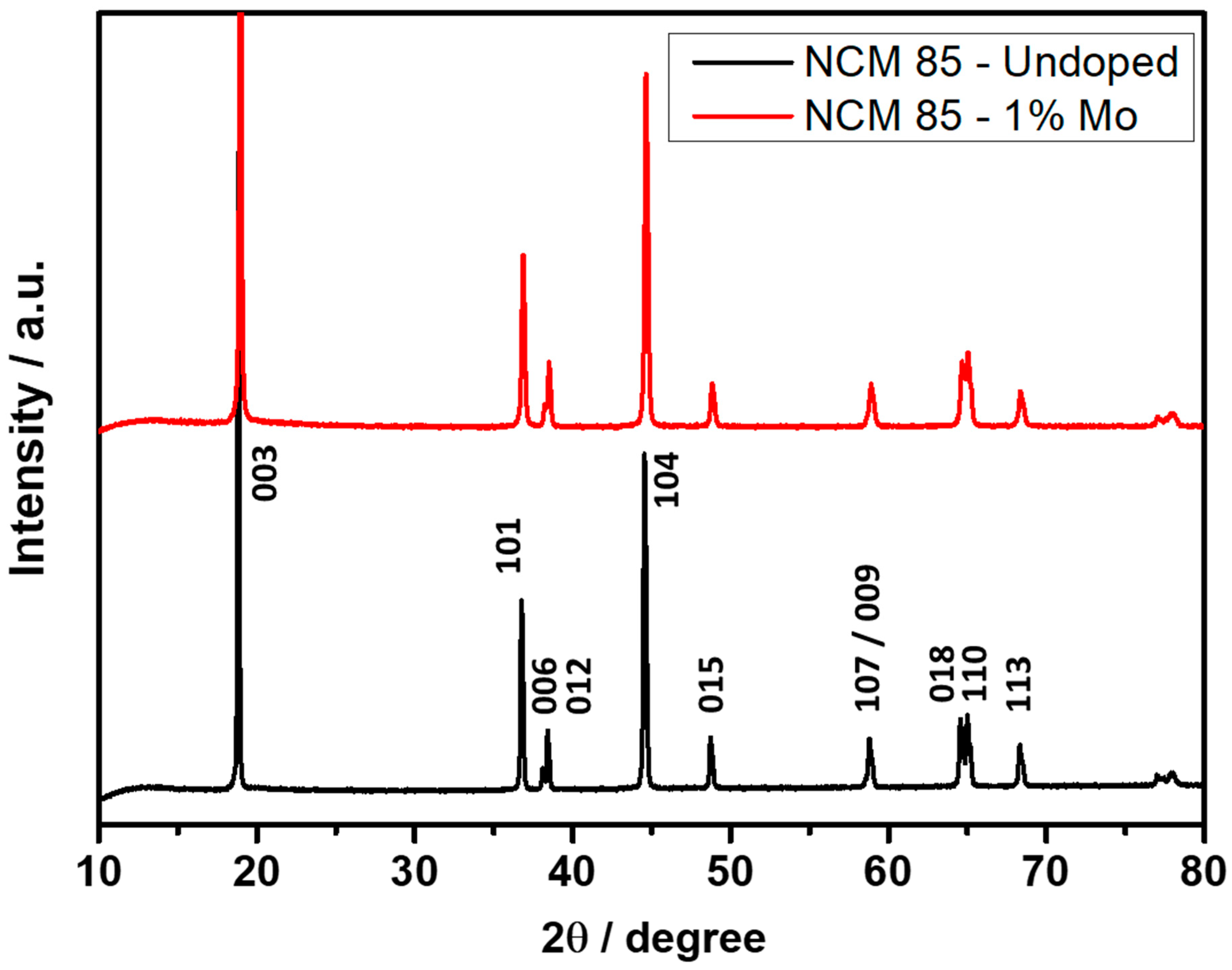
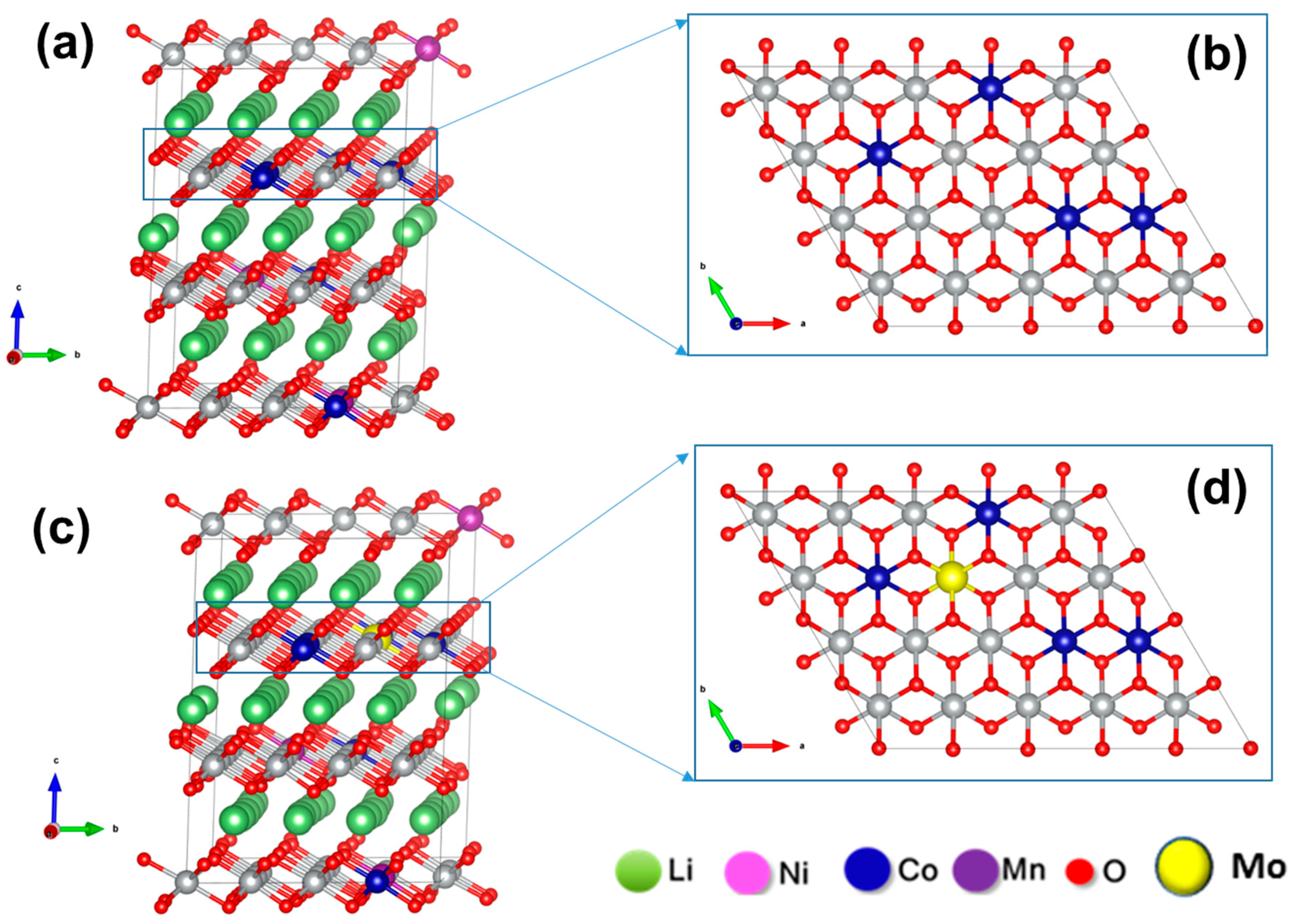
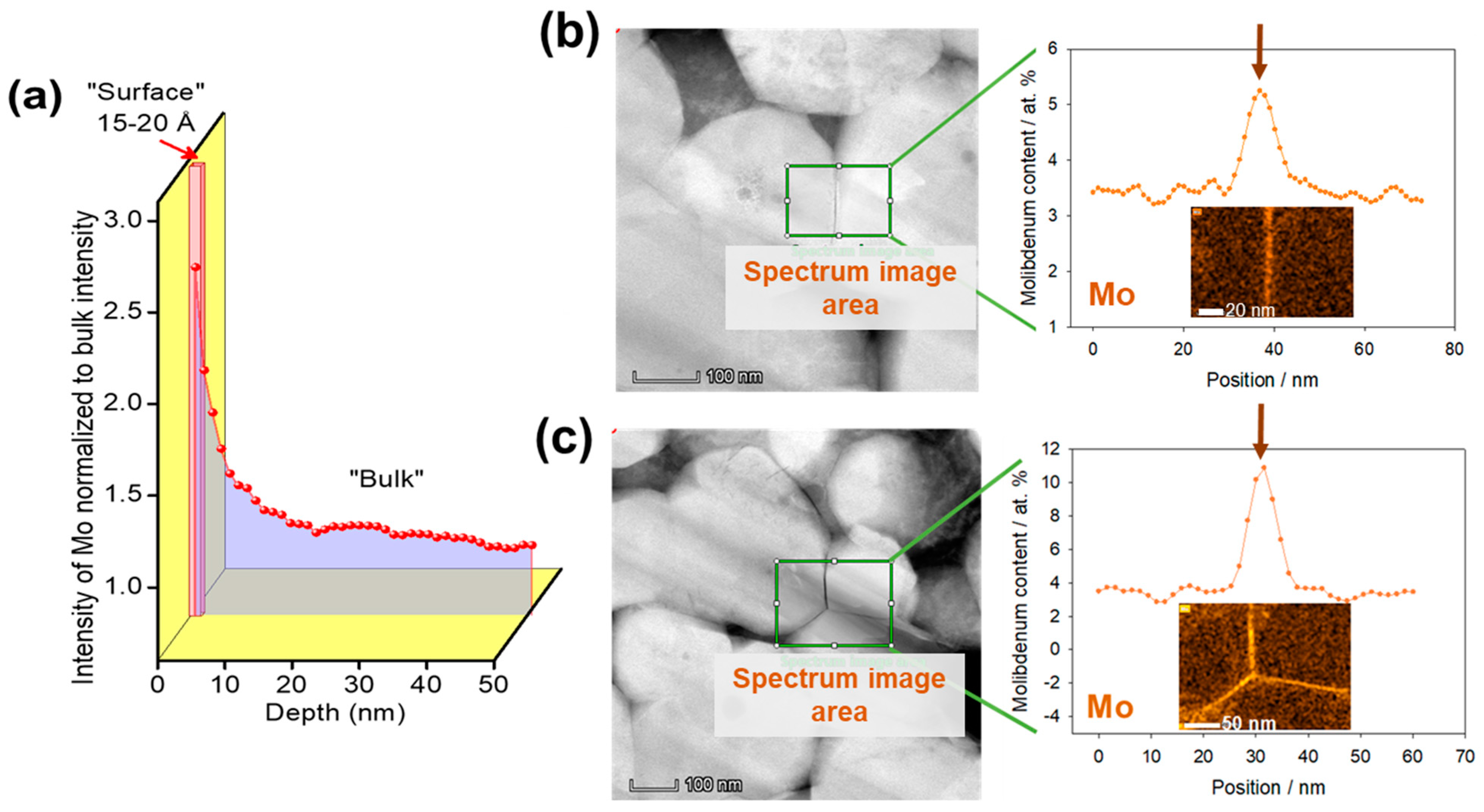
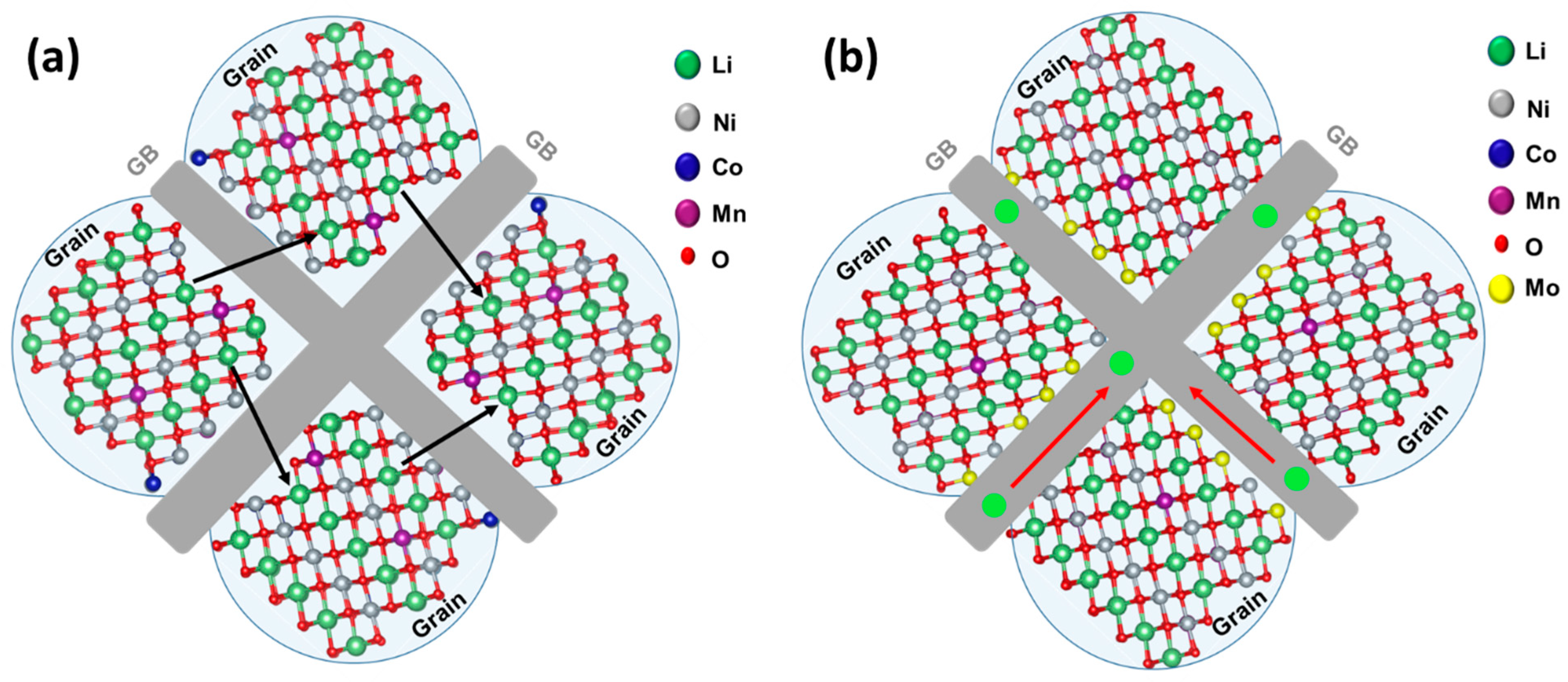
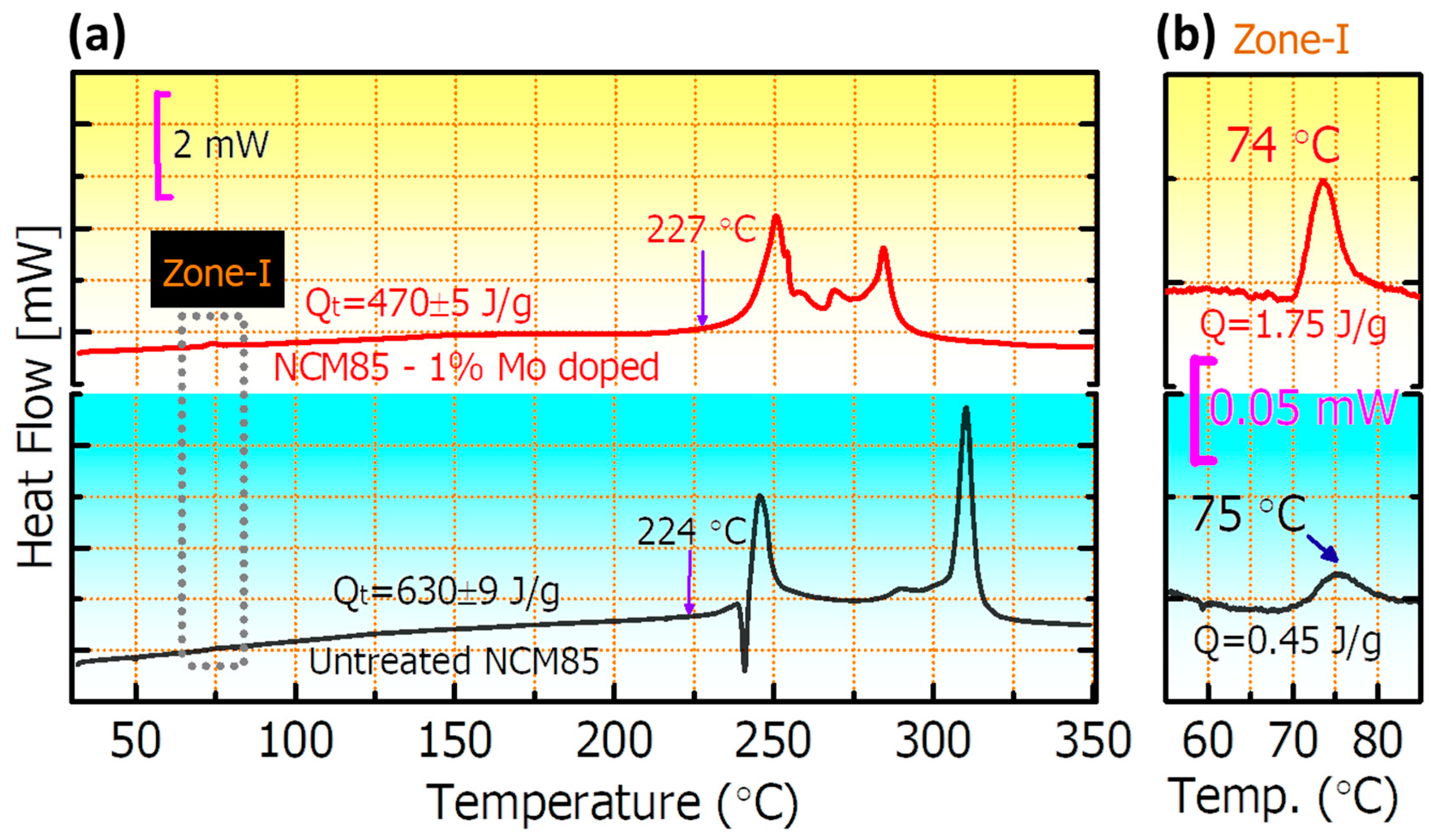

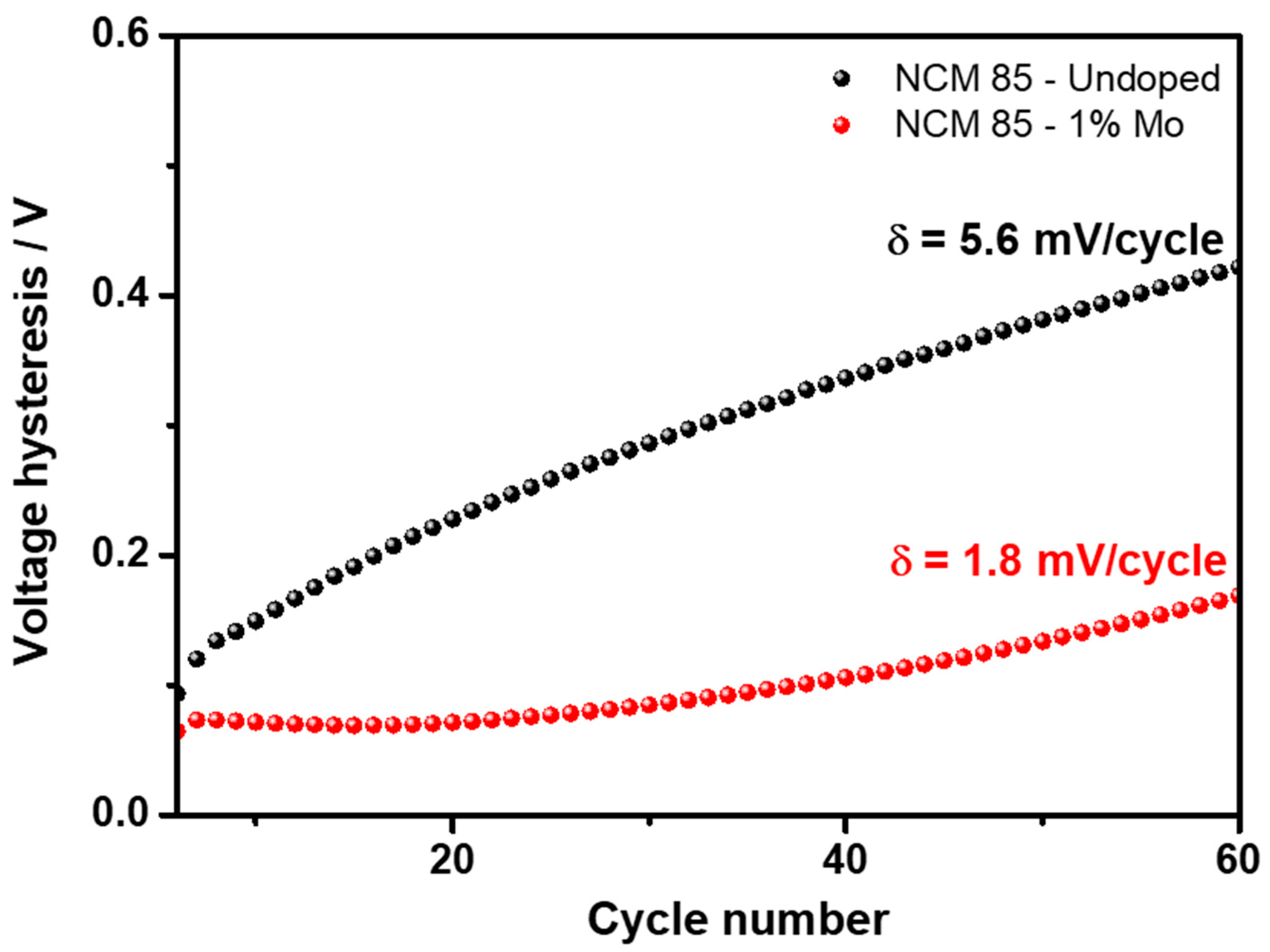
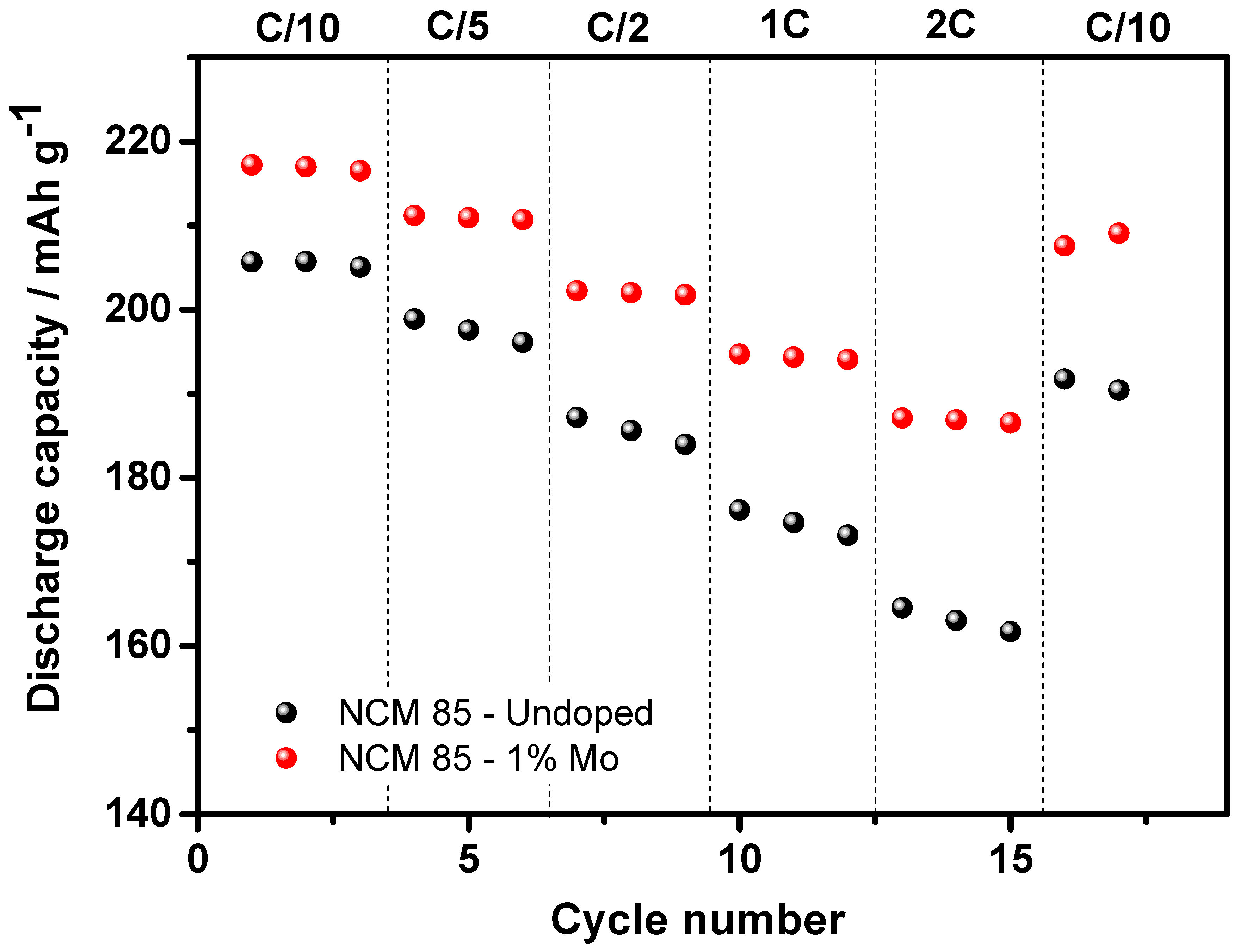
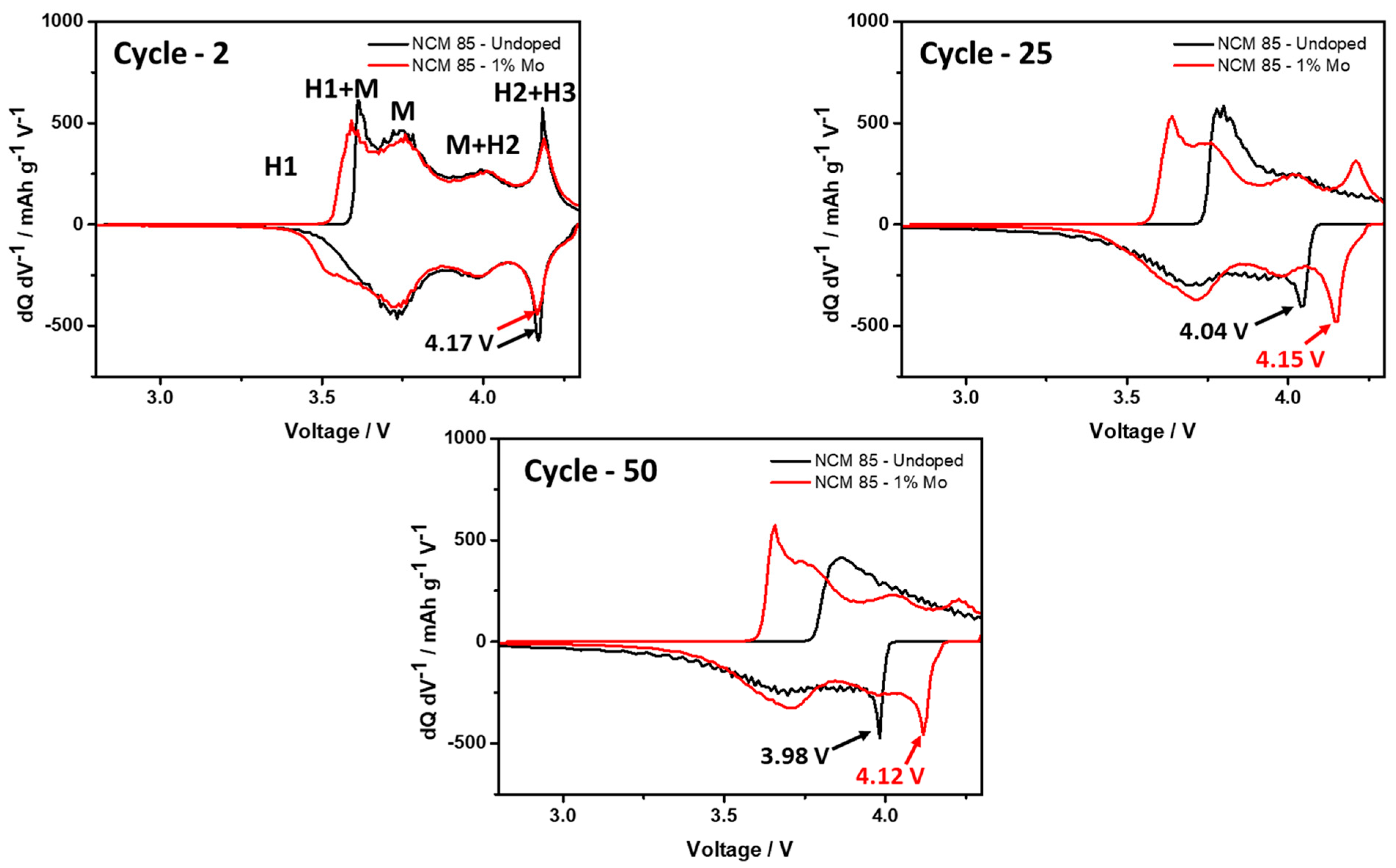
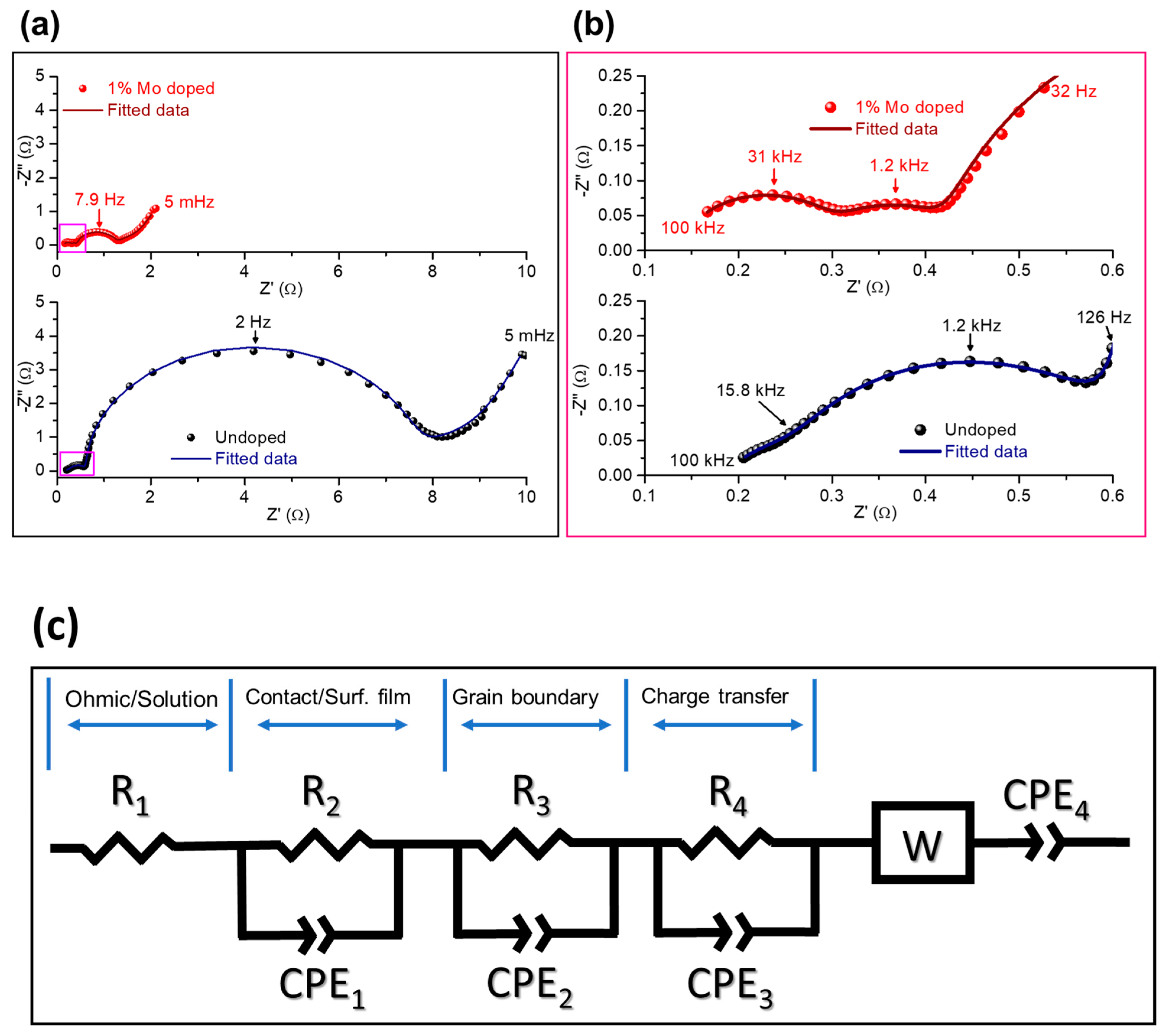
| Sample | Ni | Co | Mn | Mo |
|---|---|---|---|---|
| NCM85—Undoped | 85.4 | 9.8 | 4.8 | - |
| NCM85—1 at. % Mo doped | 84.1 | 10.0 | 4.9 | 0.96 |
| Samples | a/Å | c/Å | c/a | Mean Coherent Domain Size/nm | Ni2+ in Li-Layer | I003/I104 | (I012 + I006)/I101 |
|---|---|---|---|---|---|---|---|
| NCM85—Undoped | 2.87002(3) | 14.1882(3) | 4.94 | 123.2(9) | 0.050(5) | 1.149 | 0.453 |
| NCM85—1 at. % Mo doped | 2.87343(3) | 14.1920(3) | 4.94 | 81.1(9) | 0.050(5) | 1.257 | 0.419 |
| NCM85-Undoped | NCM85-1% Mo Doped | |||
|---|---|---|---|---|
| Charge | M + H2 | H2 + H3 | M + H2 | H2 + H3 |
| Cycle 2 | 4.00 | 4.18 | 4.01 | 4.19 |
| Cycle 5 | 4.00 | 4.20 | 4.02 | 4.19 |
| Cycle 10 | 4.02 | 4.21 | 4.02 | 4.21 |
| Cycle 25 | 4.03 | 4.23 | 4.02 | 4.21 |
| Discharge | M + H2 | H2 + H3 | M + H2 | H2 + H3 |
| Cycle 2 | 3.98 | 4.17 | 3.99 | 4.17 |
| Cycle 5 | 3.98 | 4.15 | 3.98 | 4.16 |
| Cycle 10 | 3.96 | 4.09 | 3.98 | 4.16 |
| Cycle 25 | 3.92 | 4.04 | 3.98 | 4.15 |
Publisher’s Note: MDPI stays neutral with regard to jurisdictional claims in published maps and institutional affiliations. |
© 2021 by the authors. Licensee MDPI, Basel, Switzerland. This article is an open access article distributed under the terms and conditions of the Creative Commons Attribution (CC BY) license (https://creativecommons.org/licenses/by/4.0/).
Share and Cite
Susai, F.A.; Kovacheva, D.; Kravchuk, T.; Kauffmann, Y.; Maiti, S.; Chakraborty, A.; Kunnikuruvan, S.; Talianker, M.; Sclar, H.; Fleger, Y.; et al. Studies of Nickel-Rich LiNi0.85Co0.10Mn0.05O2 Cathode Materials Doped with Molybdenum Ions for Lithium-Ion Batteries. Materials 2021, 14, 2070. https://doi.org/10.3390/ma14082070
Susai FA, Kovacheva D, Kravchuk T, Kauffmann Y, Maiti S, Chakraborty A, Kunnikuruvan S, Talianker M, Sclar H, Fleger Y, et al. Studies of Nickel-Rich LiNi0.85Co0.10Mn0.05O2 Cathode Materials Doped with Molybdenum Ions for Lithium-Ion Batteries. Materials. 2021; 14(8):2070. https://doi.org/10.3390/ma14082070
Chicago/Turabian StyleSusai, Francis Amalraj, Daniela Kovacheva, Tatyana Kravchuk, Yaron Kauffmann, Sandipan Maiti, Arup Chakraborty, Sooraj Kunnikuruvan, Michael Talianker, Hadar Sclar, Yafit Fleger, and et al. 2021. "Studies of Nickel-Rich LiNi0.85Co0.10Mn0.05O2 Cathode Materials Doped with Molybdenum Ions for Lithium-Ion Batteries" Materials 14, no. 8: 2070. https://doi.org/10.3390/ma14082070







